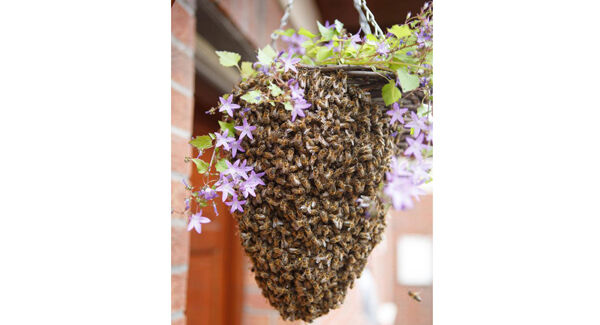Unlike in the movies a swarm of bees will not pester, chase or attack people

A swarm in May is worth a stack of hay; a swarm in June is worth a silver spoon; a swarm in July ain’t worth a fly.......
Unlike humans, the honeybee mother, the queen, and the mature bees, move out of home to set up house elsewhere around now, leaving the next generation at home to fend for themselves.
When a queen honeybee leaves a hive to make a new home, she brings a large number of honeybees with her and this group is generally known as a swarm.
The swarm is typically a colony of older bees in the process of searching for new location in which to establish a nest.
Honeybees generally swarm in Ireland between early May and late July. An early, warm spring may cause bees to swarm a little earlier in some places, but this year the first swarms were seen at the beginning of May.

The timing of swarming will largely depend on the availability of food and the bees will respond quite quickly to an abundance of spring forage.
Beekeepers will try to prevent swarms happening, as a swarm generally represents a loss of bees resulting in less or no honey production and a reduced ability to over-winter colonies due to a smaller colony size.
The earlier a swarm happens the better the chances for recovery, hence the beekeepers’ saying above. However, swarming is something that most, if not all, beekeepers will suffer from and seek to control through swarm control or prevention.
Swarms can vary in size from something like 2,000-3,000 bees to 20,000-30,000. The number of bees in a swarm tends to be related to the size of the original colony from where it has come and how many swarms have already left the colony before.
The first swarm to leave the hive (the Prime Swarm) is the largest and can contain 50%-60% of all the worker bees.
The prime swarm is often followed by one or more secondary swarms (casts), each with a smaller number of worker bees. Eventually, the original colony may be left with only 10%-25% of the bees it started with.
In preparation for swarming, honey bees gorge on honey prior to their journey. When they are ready to go, the bees leave the hive and can appear as a cloud in the air.
We tend to spot them when they are resting as a cluster with the queen at their centre. Without her, there is no future for the colony.
The swarm tends to go through a few different phases whilst it finds a new home. The queen is often forced out of the hive by the workers, who guide her to an appropriate local resting place such as a nearby fence post, tree or hedge.
The workers and drones follow the pheromones of the queen and the swarm undergoes a period of settling with more bees joining from the original colony. Lots of bees will be flying for some time while the swarm clusters around the queen.
If left undisturbed the swarm tends to remain calm and tightly massed, while scout bees fly off to find a suitable, permanent home. Depending on how quickly the scout bees find a suitable hollow, the swarms may remain in place for two days or so.
Once a suitable location is sourced, the scout bee will perform a dance giving details of the location to the other bees. Additional scouts fly off to investigate and report back with their own dance.
The strength of the dance (in terms of numbers of bees performing it and strength of the movements in the dance), determines whether or not the swarm flies off to the newly found location.
Once they have decided, the bees fly off en masse, leaving little trace behind them.
When settled in a tight cluster the bees are often quite docile and can be approached without much problem.
This is the point at which they are at their easiest to catch by the beekeeper.
The swarm can, depending on where they are located, be knocked or brushed into a box with relative ease and without too many taking to flight.
If however, the bees are actively flying around in large numbers, eg when the swarm is just settling, the bees can be a bit aggressive.
A swarm is quite vulnerable and will defend itself if interfered with. However, unlike the movie portrayals, swarms do not pester, chase or attack people.
The best thing to do is leave them alone or move away from a swarm that is actively flying around— a swarm is only a temporary phenomenon and will move on after a day or so.
Swarming bees will mainly seek out some kind of cavity in which to make their new home. Wild bees would typically seek out hollows in trees and in rock faces anywhere from 3 -10 metres from the ground.
The hollow must offer sufficient protection from the elements and the entrance must be small enough to defend.
The bees will often use propolis ( a resinour bee glue collected from tree buds), to reduce entrance sizes to around 1-1½cm in diameter.
The bees will seek out a hollow which is large enough to accommodate a large colony — which will be anything of 40 litres upwards. For this reason, honey bees do not occupy bird boxes (whereas bumble bees often do).
Occasionally, swarms will make their home in open spaces beneath some kind of overhang. Once a swarm finds a new home and becomes established, then it is very difficult to remove them.
So if you see a resting swarm before it moves off to its newly found home, do not wait long before contacting a local beekeeper who will come and collect them.
Your local beekeepers’ association website will have a list of beekeepers who will collect swarms. See www.irishbeekeeping.ie













